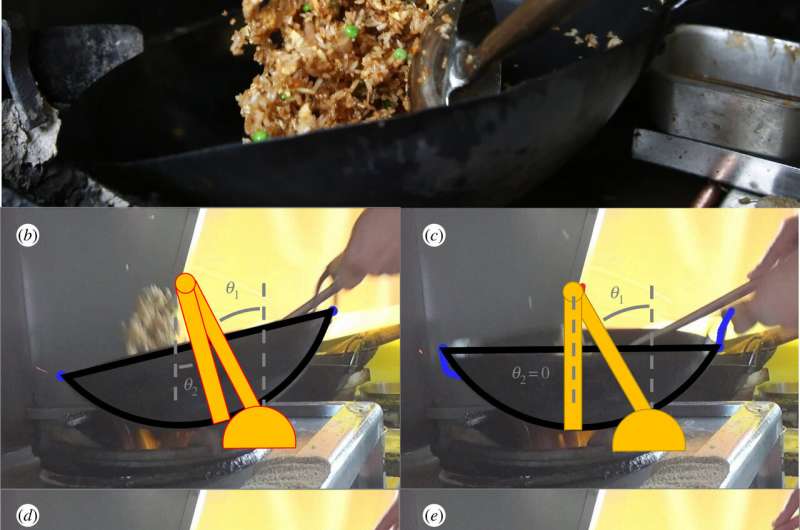Kinematics of tossing fried rice. (a) Wok tossing at the Chin Chin restaurant in Atlanta, GA, USA. Photo credit: Candler Hobbs. (b–e) Image sequence showing the wok tossing process. The coloured points show several points tracked in the video. Note that the left rim travels in a clockwise circle and the right rim in a counterclockwise circle. Both trajectories are marked in blue while the trajectory of the wok centre is marked in red. Our two-link pendulum model is overlaid on top of the image sequence to show the evolution of the model variables θ1 and θ2. Credit: Journal of The Royal Society Interface (2020). DOI: 10.1098/rsif.2019.0622
A pair of researchers at the Georgia Institute of Technology has unraveled the physics behind the optimal way to toss fried rice while it is cooking. In their paper published in Journal of the Royal Society Interface, Hungtang Ko and David Hu describe filming chefs in Chinese restaurants cooking fried rice and what they learned about the physics involved.
In Chinese restaurants, chefs use their woks to toss fried rice as it cooks. As part of their training, they are taught to toss the rice in a certain way—this allows for cooking at very high temperatures without caramelizing and burning. But what are the physics involved, and is it the cause of shoulder pain in chefs? To find out, the researchers received permission to use high-speed cameras to capture the action at several Chinese restaurants in China and Taiwan.
In slowing down the video, the researchers observed that all of the chefs used nearly identical tossing patterns. They found that the chefs very rarely lifted the woks off the stove—instead, tossing was achieved by pivoting the pans on parts of the stove. The woks were made to mimic pendulums using a point on the bottom of the pan as one fulcrum and a contact point between another part of the wok and the stove as the other. This allowed the chef to move the wok back and forth, even as they maintained a see-saw motion. The video also showed that the technique used by the chefs required a degree of skill to heft the rice into the air at just the right height, and to keep it from spilling out of the pan. It also showed that on average, the chefs tossed the rice in their woks 2.7 times per second.
The researchers also noted that it was not just the tossing that accounted for the special taste of fried rice—other factors such as ingredients and sauce preparation played a role, as well. They conclude that the constant tossing of the rice in the wok likely led to shoulder pain in 64.5 percent of chefs they spoke with. They note that simulations of the process indicate that the whole process could very likely be performed by a robot.
Credit: Journal of The Royal Society Interface (2020). DOI: 10.1098/rsif.2019.0622
More information: Hungtang Ko et al. The physics of tossing fried rice, Journal of The Royal Society Interface (2020). DOI: 10.1098/rsif.2019.0622
Journal information: Journal of the Royal Society Interface
© 2020 Science X Network
























